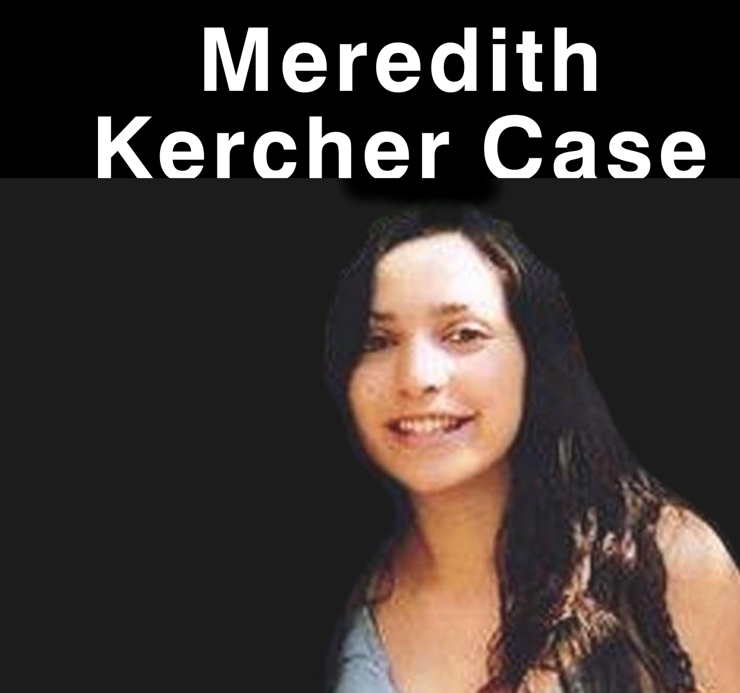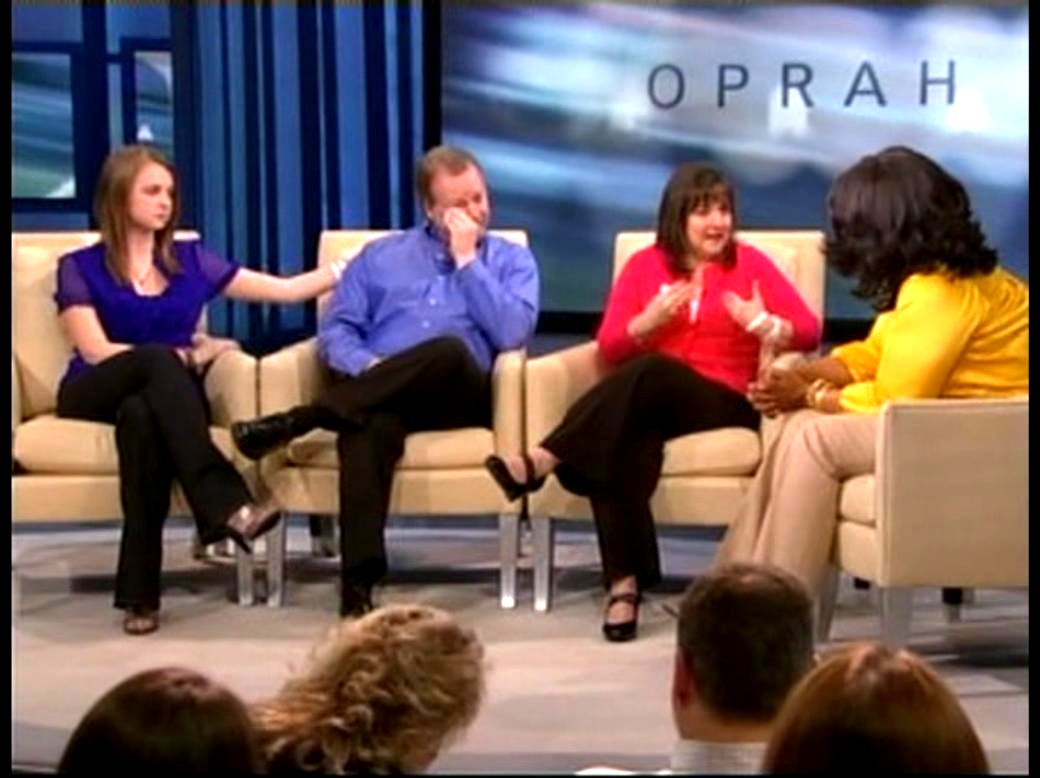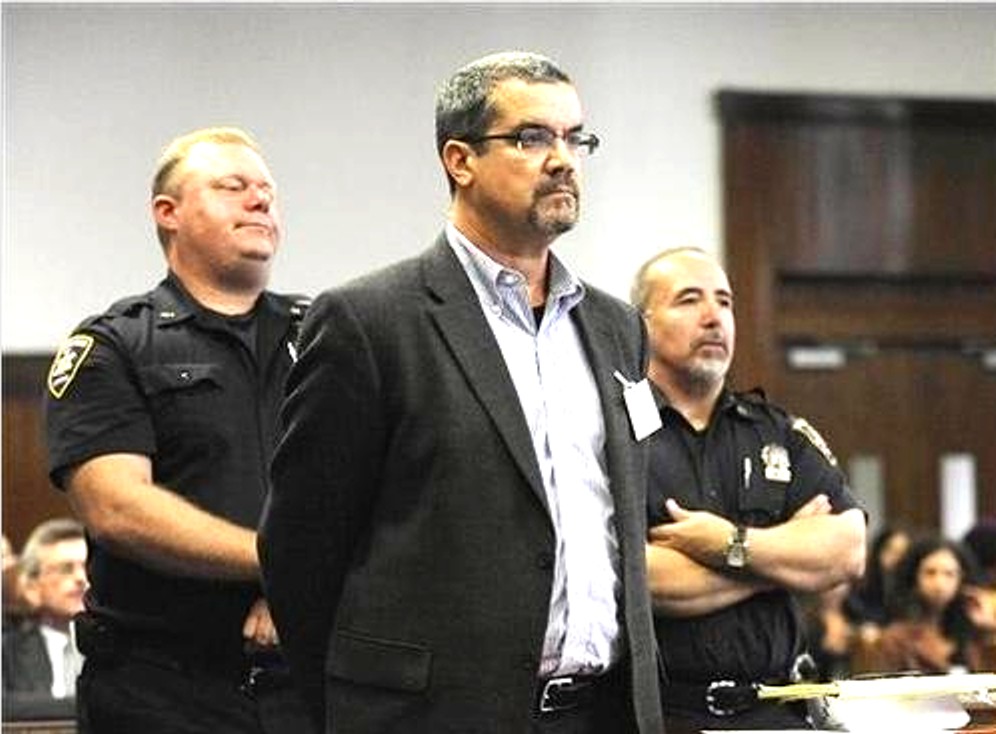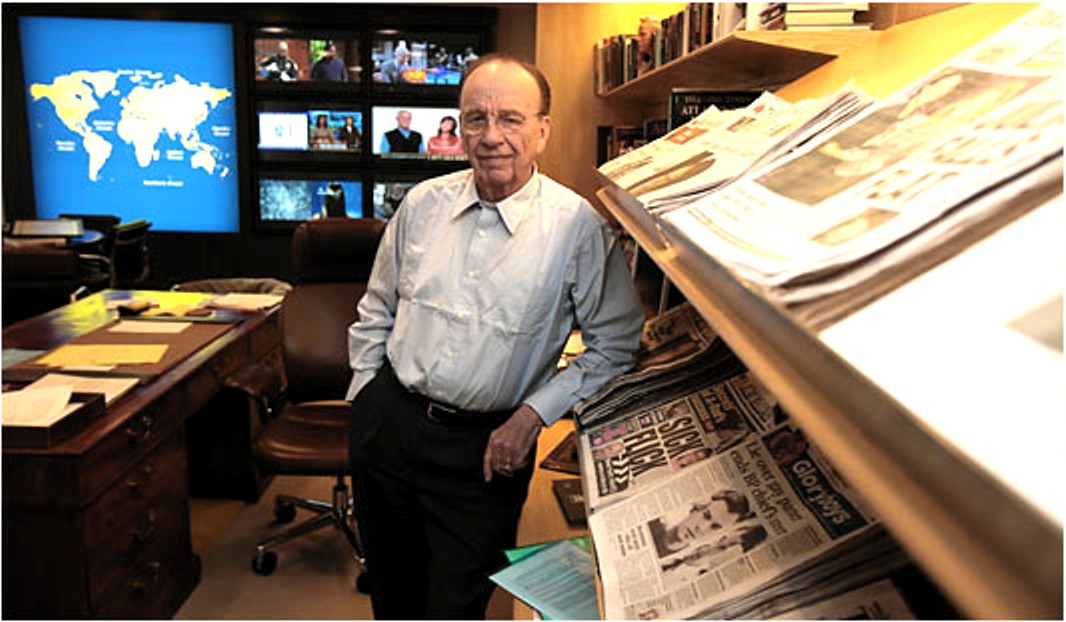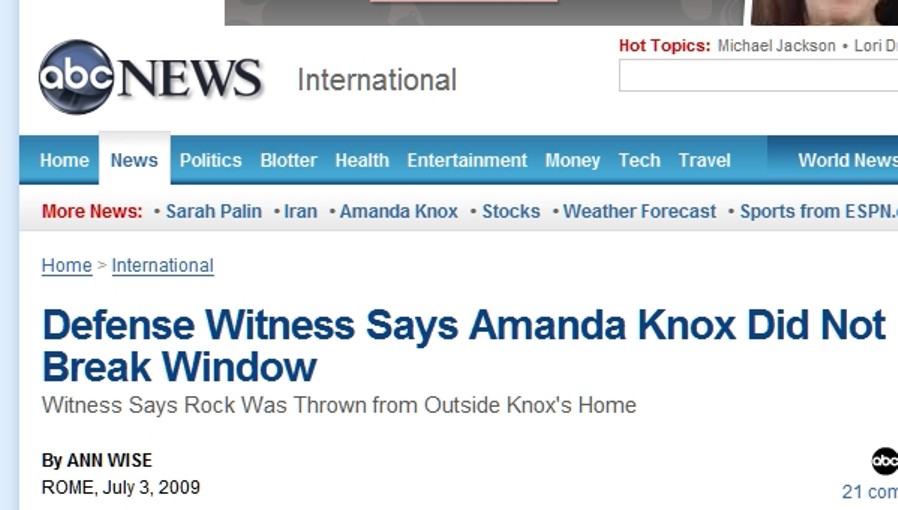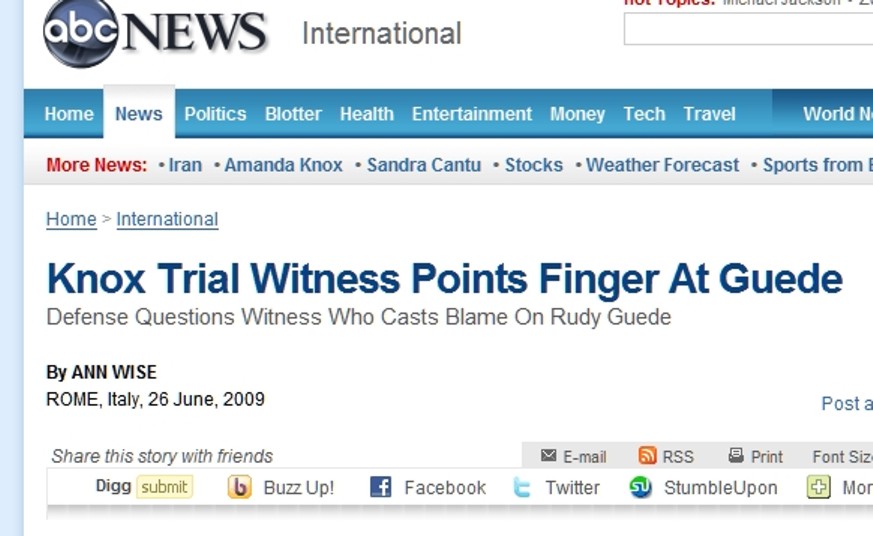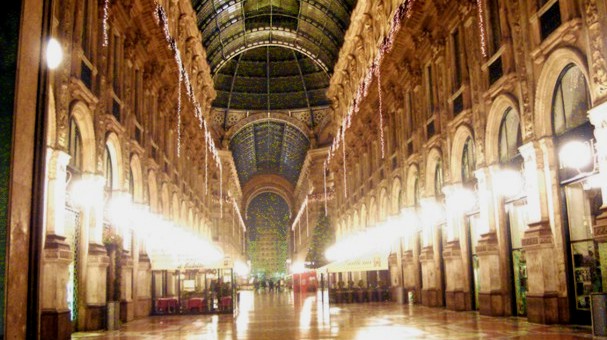
Category: ABC Network
Friday, September 14, 2012
Questions For Sollecito: Katie Couric, Push Back Against Sollecito’s Bluster And False Facts
Posted by Our Main Posters

Last Monday at 3:00 pm in the ABC TV1 studio on West 66th in New York city, Katie Couric launched a one-hour talk-show which will run five days a week. Next tuesday she will interview Raffaele Sollecito.
Who is Katie Couric?
In the fifteen years leading up to 2006, Katie Couric was a lively, bright and often very funny morning-show compere on NBC’s Today show . In 2006, she switched to CBS, to become the first woman to anchor the evening news. She also did a number of interviews for CBS’s 60 Minutes airing on Sunday nights.
In those years, she cultivated the broadest range of interview styles of anyone in American TV. Many of her interview questions are sympathetic puffballs. Her own husband died of cancer in 1998 when he was 42 and she 41, with two daughters not yet in their teens, so she relates unusually well to guests who have had tragedies in their own lives.
At other times, though, she can be as tenacious as a tiger. In 2008 she did a series of interviews with Sarah Palin, the Republican vice-presidential candidate, in which Palin looked far from ready for prime time. Palin and John McCain, the presidential candidate, lost the election to Barack Obama and Joe Biden by a substantial margin.
Some still blame Couric for asking Palin the few “gotcha” questions which stumped her, though in general it is accepted that Couric helped to show up somebody too misinformed, strident and shoot-from-the-hip to be a president-in-waiting. A recent movie version confirmed this.
So which Couric will viewers see weekdays on ABC? The puffball thrower, or the tiger? Almost certainly a bit of both, for ABC hope it is this danger and uncertainty in Couric’s interviews that will drag millions of viewers in daily.
The Sollecito interview next tuesday
For Katie Couric, this represents a good opportunity - she could really make news here - and maybe something of a risk. The risk comes only if she is briefed only by the Knox-Sollecito PR people and the book agents and book publishers that handle Sollecito.
She may leave her millions of viewers only dimly aware of Sollecito’s true legal status, and presuming that both Sollecito and Knox are off the hook, and that there is “no evidence”, and that those meanie Italians have done something really nefarious.
All of the media reports on Sollecito and Knox this past week that said “they were acquitted” have it seriously wrong.
This is merely the interval between the second act (the first appeal of 2011) and the third (the Supreme Court appeal 0f 2013) which will start playing out on 23 March. There could be several more acts to come, maybe including a complete repeat of the first appeal, which the Supreme Court has not hesitated to insist on before.
Meanwhile, Sollecito’s correct legal status under Italian law (along with that of Amanda Knox) is that he still stands accused of murdering Meredith, until the Supreme Court signs off on a verdict.
The risk for Couric is that if she does only a puffball interview, and allows herself to be snowed by the dishonest PR and in effect turned into yet another shill, she could come down on what could soon emerge as the losing side, and helped build sympathy for a killer.
We just saw the perfect example of this. A senior psychology professor at the John Jay College of Criminal Justice, less than 10 minutes walk from ABC’s west-side studios, swallowed the PR line on Knox and Sollecito without the slightest checking. You can read his sorry story here and here.
Since then, only an embarrassed silence.
This is a 20 point road-map of the Perugia case for the Couric people and any new readers that her show sends to TJMK and PMF. Post (2) will have some really tough questions, which Sollecito can be expected to flunk. With luck, these posts will turn Couric & company into tigers. Enjoy the hot seat, Sollecito.
1. Sollecito is not the real victim in this case
While Couric’s predecessor Oprah was snowed by the PR 18 months ago, she did to her credit remember Meredith, and closed with a huge photo of her that lingered. This is the real Meredith as an in-memoriam post described her.
Meredith really hit the ground running in Perugia. She had dreamed of it for a long time.
She bonded immediately with her two nice Italian flatmates, who were both working in town, and soon with the neighbors downstairs. Within days she had an “instant crowd’ of the girls from Leeds and other UK universities.
She liked the house, liked the clubs, liked walking Perugia, liked the culture and the fun festivals in Perugia. Her first encounters with her new boyfriend downstairs, an Italian musician, were said to be shy and sweet.
And she was focused and already working her tail off. She had won a well-funded Erasmus grant and although she wanted to work a little, she had no worries about money.
She arrived with an excellent command of Italian after two years of hard study at the European Studies school in Leeds, and at the Università per Stranieri she was clearly going to excel.
She was also studying politics and economics at the main university, which was very close, and she seemed set to go very far. her eyes were already on the powerful international bodies in Brussels.
2. Italy’s excellent justice system is very pro defendant
Prosecutors have to jump through more hoops than any other system in the world. Major errors and framings of innocent parties never make it through to a final guilty verdict. Please read here and here.
Proportionally Italy has only one-seventh the murder rate of the US and proportionally less than one-twentieth of the prison population of the US. Hardly a justice system out of control. .
3. Meredith’s murder was a cruel and depraved act
Although a key trial session on the barbaric 15-minute struggle with Meredith was closed to the public Italians know how cruel and depraved it was and how it HAD to have involved three attackers.
4. The case was well investigated and well prosecuted
The investigation and crime-scene analysis resulted in a very powerful case at trial as that long series of Powerpoints brilliantly summarises
The judges’ reasoning was brilliant and precise and showed NO media influence, NO satanic theory, NO desperate prosecutor, NO rush to judgment, and NO hint that it had all been inspired by Knox’s and Sollecito’s quirky callous behavior after Meredith died - that behavior by the way suggested they enjoyed toying with the police until they were finally arrested.
They were convicted based on clashing alibis, autopsy evidence, blood evidence, footprint evidence, cellphone evidence, computer-use evidence, eye-witness evidence, and so on and on. Quirky callous behavior (which did happen) was barely on the radar at trial.
5. Knox and Sollecito were never cross examined at trial
Had they been, they would almost certainly have collapsed almost instantly - as Couric hopefully will find out.
Instead, the defendants made repeated unchallenged statements to the court, as the Italian system allows, many highly self-serving, and when Knox took the stand only to explain why she fingered Patrick Lumumba, prosecution questions were highly hedged by prior agreement.
These are among the many dozens of open questions (more for Sollecito in our next post) which the defendants have still never confronted.
- Here is Kermit’s list of 150 questions which so far have never been answered by either of the formerly convicted perps.
- Here is Kermit on Sollecito’s footprint on the mat which Judge Micheli and Judge Massei accepted and Judge Hellman only weakly and possibly illegally rebutted.
- Here again is the Machine on RS’s various alibis the strange arc of which two years later is still unexplained.
- Here is lawyer SomeAlibi’s list of evidence points of a year ago which Hellman weakly rebutted or ignored and which still call for convincing explanations.
6. This was no lone wolf crime by Rudy Guede alone
After a fatuous failed attempt by a defense attorney to have a tall athletic staff member climb through Filomena’s bedroom window the defenses NEVER EVER argued that Guede acting alone could have done it.
They simply ignored the evidence of a rearranged crime scene in that bedroom and at appeal introduced TWO conflicting witnesses Mario Alessi and Luciano Aviello to try to show other people were involved. Both collapsed under examination.
7. Investigative and prosecution staff performed just fine
Curt Knox’s campaign and American media have carried out what looks to us like the real frame here, that of claiming (only in English) that the police and investigators and prosecution were corrupt or incompetent or driven by Satan.
NONE of this conspircacy theory is believed by anyone in Italy who knows about it. Police and investigators and prosecution had every chance to explain themselves (in Italian) in the court and newspapers and on TV. Read here and here and here and here.
8. The “guilty” trial outcomes convinced more than Italians
With few exceptions Italians continue to regard Sollecito and Knox as guilty. No wonder he is so desperate to get out of the place. He was never ever very popular there, and prior to Meredith’s murder he came across like a perverted loner with a drug habit who needed constant supervision by his father.
In 2008 when Sollecito was being transported to Verona University for an entrance exam in virtual reality (which he failed) he was yelled at by an angry crowd when the police van stopped at an autostrada service area for a restroom break. He was bundled back in and the police van took off in a hurry.
The entire officialdom of Perugia holds a pro-guilt view. Umbria’s chief prosecutor Dr Galati holds this view. Relevant officials in Rome all hold this view. Probably 95 percent of the interested Italian population hold this view. The vast majority of Italian journalists hold this view. The Rome-based foreign reporters all hold this view. A large if unknown fraction in the UK and US populations hold this view.
Behind the scenes in the NYC media a majority seem to hold this view. Some of the publishers who were offered the books hold this view. Hillary Clinton and the ambassador in Rome seem to hold this view. Many lawyers and even judges who read here hold this view. Even Knox’s and Sollecitos lawyers at trial in 2009 seemed less than firm believers in them.
Even some who knew Knox and Sollecito from way back in childhood in their home towns were unsurprised when they were first arrested and locked up in November 2007.
9. Both families face trials for attempted subversion of justice
While suggestive of a belief in their offsprings’ guilt rather than probative, both families are charged with attempts to subvert justice. Knox’s parents are being sued by the police interrogators who they claimed without evidence had abused her. (Mignini is not one of them, as he was not there.)
Charges against the Sollecito family (five of them) are more serious and are being brought by the Italian state. Read here and here and here.
10. A change of appeal judges may have been engineered
The highly qualified senior criminal judge in Perugia Judge Chiari was slated to preside over the appeal. He was mysteriously yanked at the last moment and reported angry, and instead two ill-qualified civil judges with questionable impartiality (they each had something to gain from a not-guilty verdict) presided over the appeal.
[Below: Katie Couric during a break in one of the 2008 interviews with Sarah Palin]

11. The appeal sentencing report’s quality is appalling
Our Italian lawyers say this is the most amateurish sentencing report in a murder case they have even seen. Please read here.
12. The independent DNA report’s quality is appalling
There a strong internal hint that the grandstanding American academic Hampikian might have been involved in its creation. Please read here.
13. The prosecution has lodged a very strong Supreme Court appeal
The chief prosecutor of the province of Umbria, Dr Galati, was himself until last year a deputy chief prosecutor at the Supreme Court in Rome. His expertise and credibility at this level outclasses that of all the other lawyers on the case combined. Please read here.
14. More trouble ahead for the families and defenses in other cases
Please read here. The key cases from the point of view of an outcome for Sollecito and Knox are the investigations into Alessi and especially Luciano Aviello who claimed that bribes were offered in his prison for testimony favorable to Sollecito.
That Judge Hellmann chose not to pursue that stunning claim, which could have thrown the appeal trial, is one of the points of Dr Galati’s appeal to the Supreme Court which if accepted could result in a new appeal trial.
It could also result in Sollecito’s lead lawyer Giulia Bongiorno (who is reputed to dislike him) having to take herself off the case.
15. Sollecito did a much derided interview in Italy
This was late last year after the appeal verdict. That much-watched one-hour interview with Sollecito seems to have totally bombed. Sollecito gave little away, and sounded smug, narcissistic, whiny, and sophomoric.
He probably convinced nobody of his innocence and reinforced the suspicions of those who are pro-guilt. He is said to come across 5 to 10 years below his real age, and that certainly is what happened here. After that one interview, other Italian networks were not exactly lining up for more of the same.
There are of course many excellent pro-guilt commentators in Italy, including Garofano, Sarzanini, Benedettelli, Giuttiari, and Castellini, Dont hold your breath hoping the little coward is ever put face to face with them.
16. No lawyers or media lawyers now publicly support RS
The probable problem is that they have actually got to grips with the translated court documents. Even Knox legal advisors Ted Simon and Robert Barnettt have long been silent. Please read here and here and here.
17. Several who did speak out for him looked like PR shills
Geraldo Rivera of Fox cable TV was one who bizarrely spoke out, and Jane Velez Mitchell of CNN Headline News was another. So was Joe Tacopina of ABC News, who also soon disappeared. So was Lis Wiehl. So was John Q Kelly.
18. Several good media lawyers speak out against him
In the USA Nancy Grace, Wendy Murphy, Jeanine Pirro, and Ann Coulter have all stated that they perceive guilt. Please read here and here and here and here.
19. Public relations hoaxes in attempt to help defendants
While suggestive of a belief in their offsprings’ guilt rather than probative, campaigns for both defendants have run under the Italian radar what amounted to hoaxes to mislead the American and British publics. Please read here and here.
Agents and ghost writers and publishers for the pro-Sollecito and pro Knox books also seem to fall into this category. Please read here and here and here and here.
20. Bigotry and xenophobia should be no part of any campaign
Huge strains of bigotry against Italians and black people and xenophobia against Italy have always been kept on the boil by Curt Knox’s defense campaign. Oprah Winfrey didnt realise, and she ended up in the absurd position of supporting probable white killers while pointing only to Rudy Guede, a black man, and smearing Italy.
Curt Knox’s hatchet men have made a considerable industry out of ridiculing the Italian police and the prosecution - but only in English. As explained here the police for the most part are the Italian equivalent of the FBI and considered among the finest in the world.
There were always several prosecutors at least on the case throughout the entire process, and they all followed the letter of the law. The impugning of Italian officials by falsely accusing them of crimes as Curt Knox’s campaign often does is itself a crime under Italian law.
Italians and Italian-Americans and Italian officials and black people everywhere deserve very much better than this. Katie Couric seems ideally suited to finally assert a balance and a return to decency, legality, and justice for the true victim, Meredith, and her loving family.
She should use this interview to nail Sollecito and hammer a stake through the PR campaign’s heart.
***
Next post: questions we recommend that Katie Couric put to Raffaele Sollecito.
Wednesday, June 08, 2011
It Seems Mignini Demonizer + Knox Fawner Judy Bachrach Learned Nothing In The Past Year
Posted by The Machine
Bachrach again. She never learns. Here is my post of a year ago showing how she misleads
Hmmm. Isn’t Mr Mignini already suing people for hurtful claims about him not unlike those made very dogmatically in the video above?And the similar hurtful claims made very dogmatically in the two videos down below here? Certainly Mr Mignini would seem to have what you might call a not-unstrong case.
- First, the numbers of police, investigators and judges hoodwinked would have to have been truly huge. This case has a VAST cast of characters in Italy seeking true justice for Meredith - a jury, for example, and twenty judges by present count, and a nationally known and respected co-prosecutor.
- And second, nothing in the judges’ sentencing report, which PMF and TJMK are in the final laps of translating into English, appears to back up her claims. Judge Micheli’s report a year ago, which explained Guede’s conviction and the reasons for sending Knox and Sollecito to trial, was already an almost unassailably tough document. And the report by Judges Giancarlo Massei and Beatrice Cristiani? It is even tougher.
Judy Bachrach has popped up repeatedly to straighten out us lesser beings on the case. For her, it appears to be almost a small industry. She is perhaps the most vehement and impervious of all the proponents of the notion that Amanda Knox and Raffaele Sollecito are somehow being railroaded, by a corrupt prosecutor, Mr Mignini, and an incompetent legal system.
Wouldn’t you expect Judy Bachrach, as a professional journalist and a contributing editor to Vanity Fair, to research her articles more meticulously? And to verify every single one of her claimed facts? In the same way that the Italy-based reporters we like to quote have incessantly managed to do - really quite brilliantly?
We have been analyzing Judy Bachrach’s many, many articles and TV commentaries about the case, and they all seem to point to the following conclusions.
- That she hasn’t ever read the Micheli report and doesn’t seem to have actually ever mentioned it.
- That she hasn’t had full access to the prosecution’s 10,000-plus pages file of evidence, and maybe she has had no access at all.
- That she didn’t attend the key court sessions in which highly incriminating forensic and circumstantial evidence was presented.
- That she hasn’t absorbed the numerous factual newspaper and magazine reports about the key forensic and circumstantial evidence.
- That she seems to rely either a lot or totally on sources with vested interests who feed her wrong theories and false information.
- And that she comes across to us as the reporter most often showing on US media outlets the most complete ignorance of the case.
Quite a track record. We wonder if she is really very proud of it. She seems to sound so. Now to examine the details of some of her small jungle of wrong claims.
False Claim #1
Judy Bachrach made the following claims in an article entitled “Perugia’s Prime Suspect” for for Vanity Fair.
Rudy Guede’s DNA would be found all over her dead body the next day….“His DNA was found not only all over the British girl’s body but also in his bloody fingerprint staining one of her cushions and on the straps of the bra she wore the night of her death.
Judy Bachrach’s claims that Rudy Guede’s DNA was all over Meredith’s body have long been demonstrably false. According to the Micheli report here quickly translated here there was only ONE instance of Rudy Guede’s DNA on Meredith.
Where exactly did Judy Bachrach get that false information from? It clearly wasn’t from the DNA results from the tests carried out by Dr. Stefanoni and her team, or any official court documents, or the Micheli report.
And why exactly did she propagate it? Was she perhaps deliberately trying to exaggerate the evidence against Rudy Guede? Whilst playing down or completely ignoring the forensic and circumstantial evidence against Knox and Sollecito?
False Claim #2
In the same Vanity Fair article, Judy Bachrach makes the claim that “Amanda had tried three times to reach Meredith by cell phone, without success.”
If Judy Bachrach had examined the mobile phone records which are part of the prosecution’s 10,000 page report, as the court did and as we have done, she might have concluded otherwise - that Amanda Knox never ever made even one genuine attempt to contact Meredith.
Two of Knox’s phone calls lasted only 3 seconds and 4 seconds.
Judy Bachrach would have also realised that Knox’s claim that Meredith’s Italian phone “just kept ringing, no answer” was in fact a lie. And that Knox’s e-mail version of events at the house on 2 November is totally contradicted by what is in those mobile phone records.
Our poster Finn MacCool rather brilliantly drew attention a year ago now in this post here to how very, very incriminating those phone records are. (They also seem to incriminate Amanda Knox’s mother. Why doesn’t a good reporter actually ask her about this?)
Judge Massei and Judge Cristiani certainly don’t believe that Knox made a genuine attempt to contact Meredith. And they provide a very detailed explanation of why they don’t, in the sentencing report we are now translating.
And as you will soon see in that report, they also pull totally apart Knox’s email version of the events on 2 November to her friends and family in Seattle.
False Claim #3
Judy Bachrach has claimed that the bra clasp in Meredith’s bedroom was “discovered” only in January 2008.
But to complicate matters, a forensics team took a second look around the House of Horrors in January; this time they discovered a clasp that had been cut off the same bra. On that clasp they found Raffaele’s DNA.
House of Horrors? A callous way to refer to the sad place where a remarkable girl with a grieving family and many grieving friends was tortured and then deliberately left to die.
And in actual fact, Dr. Stefanoni was fully aware that the bra clasp was missing from the time she reviewed in the Rome labs the evidence collected from the crime scene - early in November. The clasp couldn’t be collected until the defense experts had agreed upon a date.
There was no other cause to the delay, and the bar clasp was never simply “discovered” at the second evidence visit in January. The forensic team went there specifically to get it. And it was actually recovered on 18 December 2007.
False Claim #4
Perhaps the reason why Judy Bachrach gets so many of the basic facts like those above wrong is that she seems to rely very heavily on sources who feed her false information. One example:
But three legal sources in Perugia (two unfriendly to Amanda) tell me the injuries sustained by Meredith were inconsistent with the blade of that knife.
All of Judy Bachrach’s “three legal sources” provided her with wrong facts.
The double DNA knife found in Sollecito’s apartment is fully compatible with the deep puncture wound on Meredith’s neck. This has been widely reported by a number of journalists in the British and American media. For example “According to multiple witnesses for the defense, the knife is compatible with at least one of the three wounds on Kercher’s neck, but it was likely too large for the other two.” (Barbie Nadeau in Newsweek).
The sentencing report of Judges Giancarlo Massei and Beatrice Cristiani also now confirms that the knife is absolutely compatible with the large wound on Meredith’s neck.
False Claim #5
Judy Bachrach claims that when Knox and Sollecito changed their versions of events they did so because things got rough.
Simultaneously, in a separate room, Raffaele, too, was questioned by police. Like Amanda’s, his version of events seemed to change whenever things got rough.
Raffaele Sollecito actually changed his version of events most dramatically on 5 November 2007 when he was confronted with the telephone records that proved that he and Knox had lied. It was then that he in effect threw Knox under the bus, and he has never really backed her versions of events on the night fully ever since.
And Amanda Knox in turn changed her version of events most dramatically when she was informed that Sollecito had admitted that they had both lied, that he was wrong to go along with her version, and that he was in effect no longer providing her with any alibi.
Knox and Sollecito’s multiple conflicting alibis did NOT happen because “things got rough”. They actually happened because Sollecito and Knox were both repeatedly caught lying. And they changed their stories periodically merely to fit the new information as it became known - and at pretty well no time after they were first caught out in their lies did the stories of the two ever match. .
By the way, wait for something of a bombshell. Judges Giancarlo Massei and Beatrice Cristiani in their sentencing report expose more lies and contradictions by Knox and Sollecito which haven’t as yet been reported in any of the English-language the media.
False Claim #6
Judy Bachrach wrote an article about the case for the website Women on the Web headlined Amanda Knox’s Abusive Prosecutor.. (Hmmm. Smart title.)
Amanda was also told if she didn’t confess she would get the maximum ““ 30 years in prison. And ““ oh yes ““ at a time when, having just arrived in Italy, she spoke pitifully little Italian, she wasn’t provided with a translator.
Judy Bachrach clearly wasn’t in the courtroom when Amanda Knox’s interpreter, Dr. Anna Donnino, gave her evidence as to all the work she did on the night of the interrogations. And Judy Bachrach clearly hasn’t read the numerous articles that actually describe the interpreter’s testimony.
False Claim #7
Judy Bachrach claims that an Italian reporter was thrown into prison for being critical of Mignini. She is clearly referring to Mario Spezi.
Mignini is no special friend to journalists. One Italian reporter who especially upset the prosecutor a while back was thrown into prison “” in isolation. An American journalist who was that reporter’s friend was interrogated so harshly that, fearing incarceration himself, he hopped the next plane back to the United States, where he started a campaign (ultimately successful) to free his friend. Their crime? They were critical of Mignini.
Spezi is currently on trial for disrupting the investigation into the Narducci case. He has NOT been charged with criticising Mr Mignini.
Judy Bachrach has made a number of television appearances on CNN and other networks in which she was scathing towards Mr Mignini and the Italian legal system. As with her articles, Judy Bachrach makes many wild and inaccurate claims.
False Claim #8
She incorrectly asserts that the defence teams weren’t allowed to produce evidence of their own DNA experts - despite the fact that the Knox and Sollecito defenses each had large teams of DNA experts testify. From the videos in this post:
The defence wasn’t even allowed to produce evidence of their own DNA experts.
Gino Professor, Carlo Torre and Walter Patumi were some of the DNA experts who testified at the trial on behalf of Amanda Knox. Professor Vinci, Adriano Tagliabracci and Francesco Introna were some of the DNA experts who defended Raffaele Sollecito.
False Claim #9
Judy Bachrach has repeatedly claimed (you can see her do so in these videos) that Amanda Knox was kept in prison for two years before her trial.
They kept her in jail for two years even before trial [although] there isn’t an ounce of real hard evidence against her” And “It was decided to keep Amanda Knox in jail for two years prior to her trial.
If Knox and Sollecito had been kept in prison for two years before their trial as someone “decided” their trial would have started in November 2009. The reality is that their trial started in January 2009 and it was originally scheduled for December 2008, just two months after Guede’s.
Judy Bachrach is not the only American journalist who is ignorant of the basic facts of the case, and responsible for some of the serious misinforming of the American public, both about the crime and about Italy.
But she sure does seem to be the only one to have made it into a little industry..
By the way, we sure look forward to the YouTubes of Candace Dempsey and Nina Burleigh propagating their own books on the case when those books are released. Will they now finally be describing the truth, the whole truth, and nothing but?
Don’t hold your breath.
Thursday, June 10, 2010
Oprah Winfrey Still Snowed: Still Helping To Advance The Fiction That A BLACK Guy Did It Alone
Posted by Peter Quennell
Sad but true. A black commentator helping to revile Rudy Guede. Certainly a historic first for Oprah - though the US media is unlikely to notice.
Oprah’s emotional fawning over the Knoxes and the Mellases (with copious shots of their kids, and some misleading statements by Ted Simon) is being rebroadcast on the ABC network this afternoon.
Click here for our previous comment - plus plenty by our insightful readers.
Saturday, November 28, 2009
Could The Italian Authorities Be Starting A Wave Of Libel + Slander Investigations?
Posted by Peter Quennell
Click above for Nick Pisa’s report on Sky News about the charges Amanda Knox’s parents are being investigated for.
The sliming of the prosecution, the police and investigators, and even the many judges in the process, never seemed to our legal contacts like a particularly good idea.
The CIA operatives trial we referred to in this post (over which the United States and the Italian prime minister could exert ZERO influence, please note) shows that Italy has a long arm and tough laws.
And the very independent judges and prosecutors are willing to take a very hard line to enforce them.
A Seattle lawyer who propagates what seems to us a pretty daffy and unfounded view of the case, made statements in the recent report by Italian network LA7 which don’t seem to have gone over very well in Italy. They may have attracted some official attention.
We dont know if the many statements made to an American audience on for example the ABC, CNN and CBS networks (most recently by New-York-based lawyer John Q Kelly) could attract investigations. But we do hear they might have all been taken note of, and it is possible the US networks might be monitoring their coverage of the case from now on.
ABC and KING-5 Seattle, both highly negative about Italy in recent months, may be particularly vulnerable.
And if and when the one administrative charge against Mr Mignini is dropped, an American crime-fiction writer and wannabe real-crime reporter might also perhaps find himself in the Italian legal cross-hairs for some very odd things he has said and written.
it will be interesting to see if any of the US-based media pick up on and report objectively on this development in Italy. Someone taking bets?
*******
Update #1: The Associated Press has just fed the defamation story to its client media outlets in the United States.
Update #2: The AP report has now gone viral. As of right now (2:00 pm New York time) Google is returning over 1500 hits. So the word is out: watch one’s tongue where Italian justice is concerned, or there may be consequences.
Update #3: Here is a safe bet based on some insider buzz. This development will make the US State Department and the American Embassy in Rome very happy. They have long wanted the sliming of Italy to stop.
Update #4: It sounds like it might make several million citizens of Seattle very happy too. They have long wanted the Mellases and Knoxes to simply stick to the truth - and address, you know, the hard evidence.
Friday, October 23, 2009
Producer Of CBS Reports On The Case “Crazy, Desperate, Stupid, And/Or Unscrupulous” ?
Posted by The Machine
Meet Joe Halderman. A CBS producer in New York. He now stands accused of blackmail.
None of the four US networks that have attempted coverage of Meredith’s case has a good record for impartial reporting, or anything remotely like a firm grasp of the prosecution evidence as actually presented.
Not one of them seems to be aware of the very careful pre-trial process or the very damning Micheli report.
Nevertheless, the overall records of NBC, ABC and CNN seem to show some slight attempt at balance.
NBC produced two extremely good Dateline documentaries, which still represent the standard to beat. ABC has a reporter in the court in Perugia, Ann Wise, who we often quote on TJMK because her reporting is generally impartial and good.
And although CNN aired the one-sided Larry King Show last week, and the wild-eyed Jane Velez Mitchel panel discussion (now disappeared from YouTube) in which the lunatics appeared to be running the asylum, CNN did have some good reporting in the early days of the case, and we hear they will attempt to report better.
CBS undeniably is the worst of the worst.
CBS has repeatedly spread bias and misinformation and slimed Italian professionals and witnesses, and for that matter Italy itself, throughout the past two years.
Here is our post on one disaster of a CBS report. And here, here, here, and here are our posts on another.
Joe Halderman of CBS (above) co-produced both of them.
Several weeks ago, Joe Halderman was arrested and charged with blackmail for apparently attempting to stiff CBS comedy host David Letterman for two million dollars.
Mr Halderman, a producer for the real-life crime show 48 Hours, entered his plea as he appeared in court in Manhattan on a charge of attempted grand larceny.
Speaking earlier, Manhattan District Attorney Robert Morgenthau said that the offence, if proven, was punishable by a prison term of five to 15 years. “Our concern here is extortion and that’s what we’re focusing on,” he said.
Mr Halderman was arrested following an undercover police “sting” operation at a New York hotel, during which he was allegedly recorded setting out his blackmail demands to Letterman’s lawyer.
Now it is being reported in New York that Joe Halderman’s story is taking a really bizarre turn.
One of the last 48 Hours stories that CBS Newsman and accused David Letterman blackmailer Joe Halderman worked on - airing just one month before he allegedly launched his plot to extort the late-night host - involved a ransom scheme…
It’s a run-of-the-mill true-crime tale of murder and deception, but it features one detail that seems strange in retrospect: The sister of one of the victims, who never got her brother’s remains from the Philippines after his murder, at one point received creepy anonymous e-mails from someone claiming to have her brother’s ashes, and offering to sell them to her….
The strange thing is, in the story Halderman reported, the ransom scheme goes haywire: The man behind the e-mail ends up attracting attention to himself and gets arrested for Rios’ murder….
We came across the weird synchronicity between Halderman’s day job and his after-hours scheming while going through his old 48 Hours segments and looking for signs that they may have been produced by someone crazy, desperate, stupid, and/or unscrupulous enough to engage in blackmail.
Hmmm. Apparently Joe Halderman is crazy, desperate, stupid, and/or unscrupulous enough to mislead a large segment of the American population about the real facts of Meredith’s murder.
Real crime seems a small step from there.
Three others who Manhattan District Attorney Robert Morgenthau might also want to keep a close eye on are CBS junior producer Sara Ely Hulse, CBS reporter Peter Van Sant, and CBS consultant detective Paul Ciolino!
All have shown themselves extremely ignorant of the basic facts of the case.
Email exchanges with the obviously obsessively pro-Knox producer Sara Ely Hulse have suggested to us that, among many other key facts of the case, she was not aware of the following:
- Amanda Knox had a criminal record in Seattle.
- Amanda Knox had met Rudy Guede on a number of occasions.
- Amanda Knox was not questioned for 14 hours without an interpreter.
- A woman’s bloody shoeprint in Knox’s size was found on a pillow in Meredith’s room.
The seemingly extremely amateurish detective Paul Ciolino was responsible for conducting the farcical experiment in Perugia in the first CBS documentary linked-to above where he could not even get the STREET right before claiming this was a railroad job from hell.
And reporter Peter Van Sant channeled some of the worst libels about Prosecutor Mignini - baseless claims about satanic sects and so on - without even being able to spell Prosecutor Mignini’s name properly!
It seems to us very odd that both Sara Ely Hulse and Paul Ciolino appear to be members of the Free Amanda Knox Facebook group. Does CBS have any guidelines at all on ethical matters or standards of reporting?
On second thoughts…. Do we REALLY have to ask?

Above: CBS reporter Peter Van Sant who repeated online unfounded libelous smears about Prosecutor Mignini

Above: Junior CBS producer Sara Ely Hulse, an obsessed Knox fan who participated in CBS’s two fiascos.
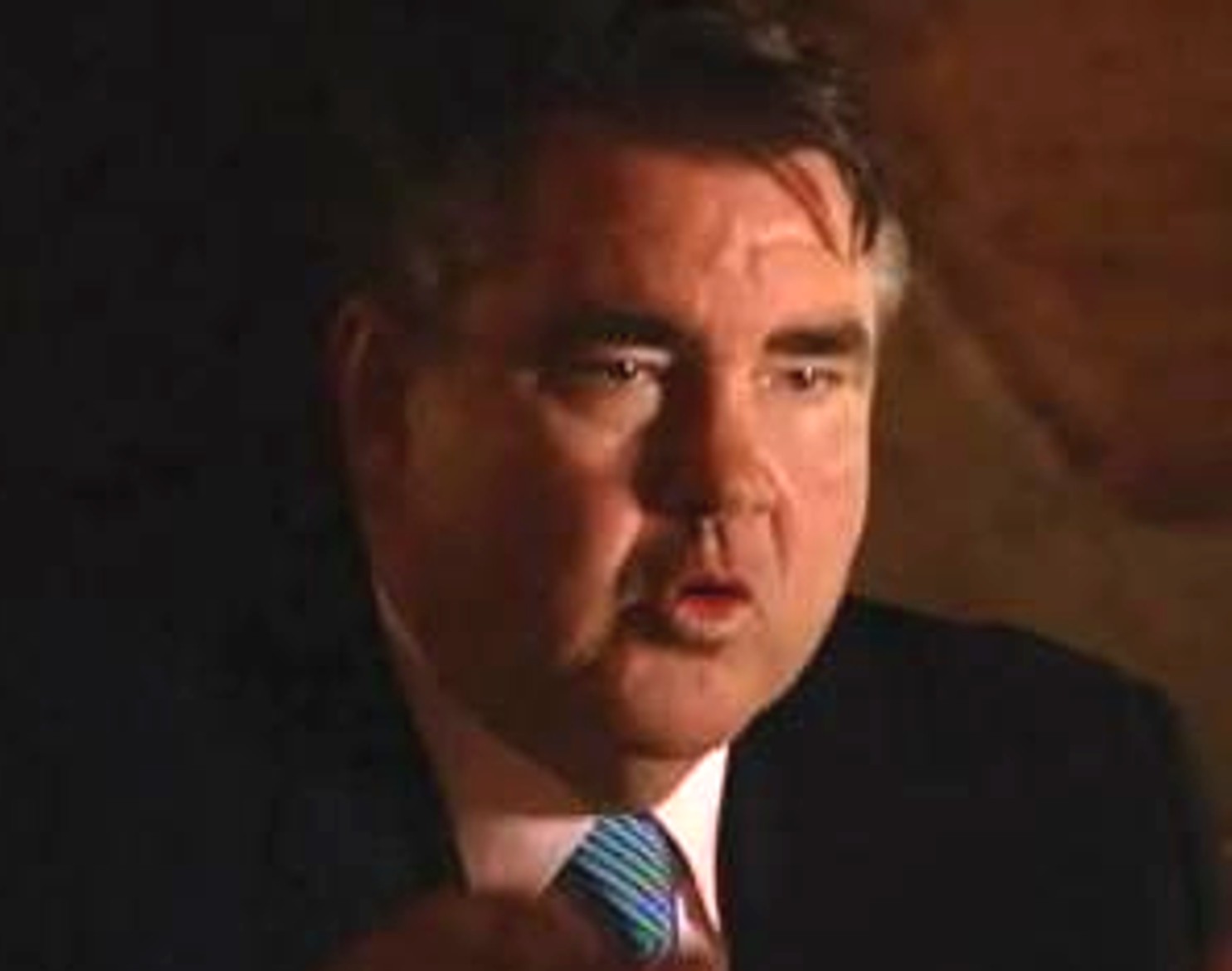
Above: CBS consultant Paul Ciolino who ran a farcical test in Perugia and also slimed prosecutor and police
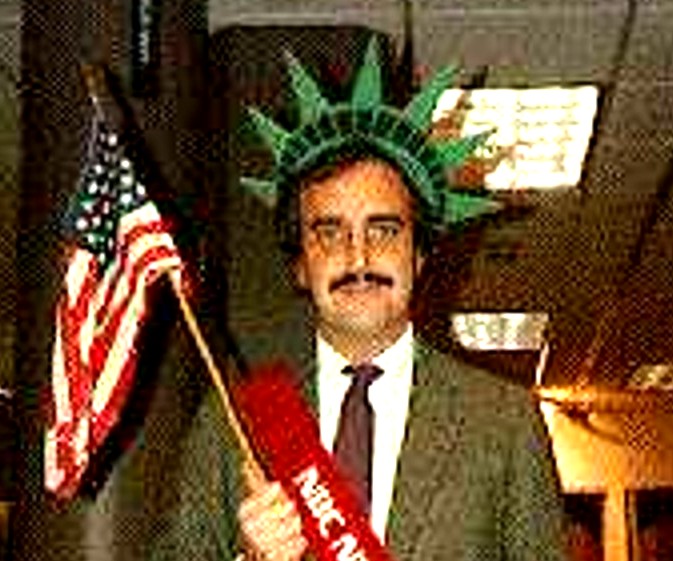
Above: Indecisive CBS producer Doug Longhini who with Joe Halderman produced CBS’s two fiascos
Tuesday, August 25, 2009
Justice V Jingoism: UK’s Sky News Tells Us They Are Seeing Hypocrisy
Posted by Peter Quennell
Click above for the report.
Sky News (controlled from NYC when last we looked! by Rupert Murdoch, above, on Sixth Avenue) says what a lot of Europeans are thinking.
A lot of New Yorkers too. A mean-spirited and dishonest PR campaign and a lazy dishonest media have colluded for far too long on this case. And on too many similar examples.
It is quite different in the US when it comes to foreign treatment of one of their own citizens.
Amanda “˜Foxy’ Knoxy, is the young American woman now on trial in Italy for the murder of the British student Meredith Kercher.
I was astonished to see her whole family, parents and children, invited on [ABC’s] Good Morning America and treated with cloying sympathy for all the world as if they were victims of a miscarriage of justice.
Sky News and the other Murdoch vehicles (the London Times, for example) have been among the MOST dispassionate about the case and among the MOST compassionate about Meredith.
Good on you, Rupert. For this, we salute you.
Saturday, July 18, 2009
Trial: ABC News Has The Only End-Of-Day English Report
Posted by Peter Quennell
Click above for Ann Wise’s report. “Rejected offer to leave” seems rather misleading.
In some of the Italian reports it is observed that Knox was told very soon after the death of Meredith was discovered that she was not allowed to leave Perugia for the time being, so she really had no choice but to stay. Cousin Dorothy and Ann Wise seem not to have known this.
In fact all of the key witnesses including Meredith’s English friends were told to remain in Perugia until the investigations were further advanced. Although it was very tough on them all because of a voracious media, they had to remain there for some weeks.
Only two witnesses were heard today - the second was the mobile phone specialist that Ann Wise mentions - leaving half a dozen witnesses to testify tomorrow or after the summer break.
We are told that the uncertainty about whether Judge Massei would be recovered enough to preside this Friday and Saturday resulted in several scheduling problems and forced absences. This is a busy press corps and few of them actually live in Perugia.
Apparently Judge Massei looked well and very attentive today, and interrogated the mobile phone specialist on his contribution to the timeline for the morning after.
Saturday, July 04, 2009
Trial: ABC News Reports On The Trial Happenings On Friday
Posted by Peter Quennell
1. Overview
Click above for Rome-based Ann Wise’s report on what happened in court today.
2. Defense Witness Demonstrates Breaking Windows
Prosecutors say Knox and Sollecito staged a break-in to make the murder appear to be the result of a botched theft. A window in the bedroom of Filomena Romanelli, Knox and Kercher’s housemate, was broken, and glass shards and a 9-pound rock were found in the room.
The prosecution presented witnesses and evidence that suggest the window was broken from the inside.
Francesco Pasquali, a retired forensic police officer hired as a consultant by Sollecito’s defense, presented a video in court that included three different scenarios showing how the rock could have been thrown from the outside to break the window, located 13 feet off the ground.
According to Pasquali, the rock was thrown from a terrace across from the window, making the glass “explode” on the inside and spreading glass fragments everywhere on the inside and the outside of the windowsill.
Pasquali said that he had re-created the same conditions that were found in Romanelli’s room at the time of the break-in. Pasquali said he constructed a window of the same size, with the same paint and the same type of glass, and threw the rock through it into a room with the same characteristics as Romanelli’s room. Two video cameras—one inside and one outside—filmed the rock being thrown through the glass.
By analyzing the trajectory of the rock and the projection of the glass shards, Pasquali said he could “exclude that the glass could have been broken from the inside.”
3. But Pasquali Has To Back Down
Prosecutors, however, contend that shutters outside the window could have prevented a rock from breaking it….
The two prosecutors in the case, Giuliano Mignini and Manuela Comodi, made a number of objections when they cross-questioned Pasquali, who admitted that he had not taken into account the fact that there were shutters on the outside of the original window.
Prosecution witnesses have testified that the shutters were partially closed on the morning after the murder, and Pasquali conceded that the closed shutters would have prevented a rock from the breaking the window from the outside.
“It does not take a technician,” Pasquali said. “If the shutters were ajar then the rock couldn’t fit through.”
As we mentioned earlier, the prosecutors also got Pasquali to admit that, besides omitting those shutters, he had also omitted the mostly-drawn curtains in his simulation.
They could have radically altered the broken-glass pattern.
4. ATM withdrawal from Meredith’s bank account
The director of a local bank, Paolo Fazi, testified that 20 euros ($28) had been withdrawn from Meredith Kercher’s account Nov. 2—the day her body was found.
But he also said that the bank accounting date does not necessarily reflect the actual date of the ATM withdrawal, and that only Kercher’s British bank would have that date.
Someone from the British bank is expected to testify in upcoming hearings. Knox and Sollecito are… accused of stealing Kercher’s credit cards, her cell phones and 300 euros ($420) in cash…
5. Guede at disco early AM
A University of Perugia student told the Perugia court that he had seen Guede at a local disco in the early morning hours of Nov. 3, after Kercher’s murder.
Pietro Camplongo said Guede was dancing alone, and that people were keeping their distance from him, because he smelled “as if he hadn’t washed.”
6. Amanda Knox family in court
[Knox during a break] graciously accepted a chocolate from Sollecito, thanking him out loud. It is reportedly the second time he has given her a chocolate.
Knox’s younger sister, Deanna, 20, appeared in court for the first time on Friday, along with Knox’s mother, Edda Mellas… Deanna Knox had been to Perugia and visited Knox in jail, but she had not returned since the trial started in January.
Knox’s half-sister Ashley, 13, also came to court Friday morning but was asked to leave by the judge, because she is a minor.
Saturday, June 27, 2009
Trial: ABC News Posts A Wrap-Up Report For The Day
Posted by Peter Quennell
Click above for the story from Rome correspondent Ann Wise.
1) Testimony on Rudy Guede
A defense witness testified that just two weeks before British exchange student Meredith Kercher was murdered his law studio was broken into and a computer and cellphone were stolen. The stolen objects were later found in the possession of Rudy Guede, who has already been convicted for his role in Kercher’s murder….
Brocchi explained in court that about two weeks after the theft, on Oct. 27, the he received a call from the police saying that they had found the stolen computer and a cellphone belonging to him (which he had not realized had gone missing). The objects had been found on a person who was picked by police up in Milan, but they did not specify who that person was.
But two days later a young black man showed up on the steps to Brocchi’s office in gym shorts and a tank top (though it was cold) holding a basketball.
Brocchi said the man spoke perfect Italian with a Perugia accent and told him that he had been caught with some things that Brocchi had reported as stolen, and just wanted to tell Brocchi that he had bought those things and paid for them at the Milan train station.
“I told him, ‘look, I have no idea who you are’,” said Brocchi in court. “And he answered, ‘I don’t know who you are either.’” Brocchi then told the young man he just wanted his things back, and shut the door…
2) And testimony from Sollecito’s cleaning lady
In what was a relatively short hearing at the trial, the judge and jurors also heard testimony today from Sollecito’s former cleaning lady.
Marina Ciriboga, from Ecuador, answered questions regarding the use of bleach as a detergent at Sollecito’s house.
Prosecutors believe Knox and Sollecito used bleach to clean up blood and other evidence on the crime scene after the murder. A number of prosecution witnesses have been questioned regarding purchases of bleach and bottles of bleach found in Sollecito’s house.
Ciriboga today said that she usually washed the floors with another detergent, but that she had asked Sollecito to buy bleach. When she stopped working for Sollecito in September one and a half bottles of bleach were still in the house, Ciriboga said.
Ciriboga also works at the small supermarket down the street from Sollecito’s house where a witness—the owner of the store—has testified he saw Knox early on the morning after the murder, when Knox says she was asleep.
Ciriboga told the court that she had never seen Knox or Sollecito at the supermarket.
Sunday, June 14, 2009
Italy Shrugs: Why Amanda Knox’s Testimony Seems To Have Been A Real Flop
Posted by Nicki
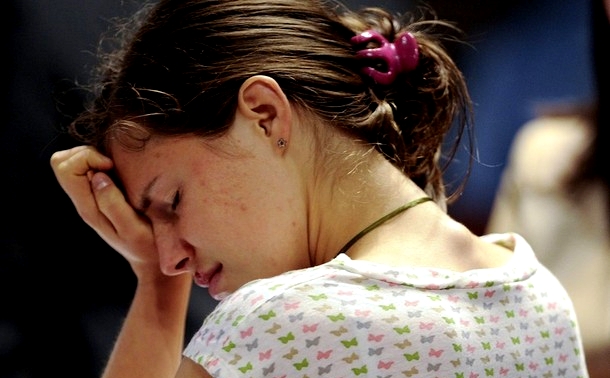
Posting from Milan (image below) where we also have been watching Knox testify in Italian.
Here are just three of the disbelieving headlines on the testimony that have been appearing in the Italian press.
- All of Amanda’s wrong moves (La Stampa)
- Amanda growls but Patrick bites (Il Giornale)
- Amanda: I am innocent. But many “I don’t remembers” start popping up (ANSA)
As many of us were expecting, Amanda’s testimony has backfired. She came across not as confident but arrogant, not as sweet but testy, not as true but a fake who has memorized a script, an actress who is playing a part but not well enough to fool the public.
It is true that the Italian media and public opinion in general have not been very benign with Knox. But not for the reasons that the American media seem to want to push.
Let’s make it clear, Amanda Knox is not on trial because Italians are unaccustomed to or even “jealous” of her freedom and lifestyle”¦ The first time we read these “explanations” we found them quite laughable.
But for many or most Italians the initial amusement has now given way to a profound irritation. Amanda Knox’s lifestyle is shared by hundreds of thousands of Italian girls, who like partying and sex as much as she does - or even more - and they live a happy carefree life with no fear of being perceived as “bad girls.” They behave no differently from any other girl of the same age in America or in any other Western country.
Dear American media, welcome to the 21st century and to globalization! Please put aside pseudo-romantic and passè vision of a country where all men chase American girls because Italian women are not as approachable for “cultural” reasons: Italian men are into foreign girls no more but no less than Italian girls are into foreign boys.
They generally greatly like Americans because of their great interest and curiosity for a country and its people that many Italian youngsters have only known through books or movies. Amanda Knox is not on trial because she is American and therefore too “emancipated”. She could even be from the North Pole as far as Italians are concerned.
What really matters to them is to find the truth about Meredith’s murder and to do real justice for her terrible death. Italians don’t much like Amanda primarily because they perceive her as a manipulative liar, who is suspected of having committed a heinous crime for which there is a whole stack of evidence - and they perceive this even more-so after this last week’s court hearings.
In addition, the US media’s seemingly endless bashing of the Italian justice system, and of the whole country, most recently by CBS and ABC, has definitely made things worse.
The Italian police are NOT known to be particularly violent - although, agreed, it may happen when they’re dealing with violent males suspects from Eastern Europe or Africa, or in the streets when they have to deal with a riot. Violence is NEVER used with white, female college students from Italy, America or elsewhere.
And Italy is a sovereign state with a great juridical tradition. Receiving condescending lectures by the media of a country where the death penalty is still applied in many states comes across as more than insulting - it is utterly ridiculous. Before you judge the “backwardness” of the Italian justice system, you should at least first read Cesare Beccaria’s amazingly humane Of Crimes And Punishments (written in 1764) and perhaps you’ll reconsider.
If the American media just cannot understand that there are alternatives to the “American way “, that may not be so bad after all. But they should at least show some respect for a foreign, sovereign state and its people.
If the media can’t even manage to do so - and they really want to help Amanda - the best thing to do now is to go quiet and let the Italian justice work at its pace and according to its own principles. If Amanda is only guilty of arrogance, callousness and narcissism, she will be free soon.
Dear American followers of Meredith and, for that matter, also friends of Amanda Knox. May I speak right to you, and right past the media?
There has been no character assassination, no demonization, no great wave of hate and revenge, no mad prosecutor, no Satan theory of the crime, no invented evidence, and no massive bumbling.
What there has been is a whole stack of evidence and a VERY careful process. Kernit in effect described all the evidence in his extraordinary 150 questions.
And on Friday and Saturday, Amanda Knox for better or worse chose to answer NONE of them.
